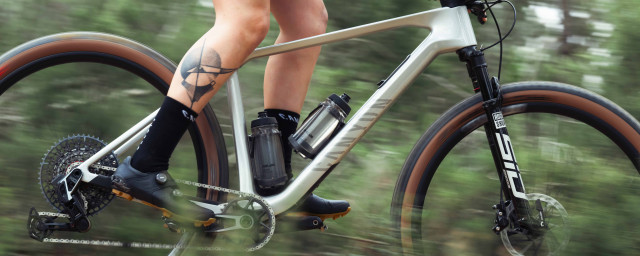[Words by Steve Thomas]
The Canyon Disruptr CFR (Canyon Factory Racing) helmet and its sleek aero sibling, the Stingr, are the German bike brand’s first ventures into helmet manufacturing. They have gone about things quite differently, by incorporating the brand-new HighBar retention system, which replaces traditional straps.
- Best mountain bike helmets 2024 - top-rated head protection for the trail
- Troy Lee Designs Grail Helmet review
- Can you use a road bike helmet for mountain bike and gravel riding?
There’s a lot going on under the lid, yet the HighBar's looks and lack of fancy bells & whistles and the high price may deter some buyers. After using the helmet for a while, it has raised a few questions about helmet safety and design for me.
Disruptr by name, disrupter by nature?
Canyon Disruptr helmet - Technical details
Canyon is renowned for being innovative and perhaps even brave, with its products and business approach, and that certainly runs true with its first helmets, the Disruptr CFR and the aero Stingr CFR. Both helmets have raised more than a few eyebrows, mostly through the highly unusual and all-new HighBar retention system and its different looks, which is undoubtedly the star attraction of the Disruptr.
Weighing in at 275g in medium, the Disruptr has a fairly standard EPS shell with 18 vents, a matte-finished polycarbonate outer layer, one small CFR logo on the rear left panel, a Mips logo, and a rear magnetic port for the matching FLASH rear light, which is not included.
The HighBar plastic retention system replaces traditional straps. HighBar is a separate US-based company, and this is its launch product, with Canyon being the launch partner. Behind HighBar were/are many prominent bike and cycling helmet designers and experts.
Two large anchors are built into the helmet, while two V arms attach to them, just in front of your ears. At their base is a “hinge” which connects to a plastic retention “strap/bar” – this is fastened up by a rachet dial.
The bar pivots down from the helmet and is rotated down beneath your chin and the dial is secured to the recommended tension.
The second crucial part of the HighBar system is the inner frame, which is plastic and attached to the helmet. This fully encircles your head and is also tightened by a rear ratchet dial. It has a four-stop height adjuster/anchor inside the rear of the helmet.
Lining this is a Mips Air Node system, which is detachable and affixed by a series of traditional Velcro patches. There is also a soft-lined storage bag supplied with the helmet.
At present, the helmet is available in matte black and white in the UK, with a grey version imminent. There are three sizes – small, medium, and large. Be sure to check the measurement charts accurately, as the HighBar system requires an accurate fit to be effective.
Canyon Disruptr helmet - Performance
Straight out of the box and you cannot miss the fact that this helmet is different or at least the HighBar retention system is. The actual helmet shell looks pretty standard. It’s nicely understated and quite well-vented but most will focus on that strange pull-down bar system and that is what differentiates this helmet from anything else on the market.
HighBar and Canyon point out that there has been little evolution or development in the strap system of cycling helmets in decades, and they are correct on that point, although some may question whether there is any need for change.
It has long been known that badly fitted helmets and sloppy straps create all kinds of potential and proven issues; the most obvious being that a wrongly fitted helmet greatly increases the risk of serious injury in the case of an accident. Loose straps flap at speed, which in turn causes strap oscillation – and that is a hit on aerodynamics and creates wind noise and ear draft at speed. The Disruptr claims to address these issues and more.
On first pulling the helmet on, I did feel like 1980s starship trooper, yet immediately noticed that the helmet fit was solid and comfortable. The front ratchet dial is tightened loosely to about a fingers-width gap to your chin, and the rear dial seemed so simple.
It did feel strange and looked even more so but only at first. The claims that this helmet and system should ensure safety by sitting correctly on your head seem to be bang-on and logical, which I have to admit surprised me. It effectively encircles and cups your head, coming down a tad lower than many other helmets, as does the helmet shell, providing a very reassuring level of coverage and stability.
As for the retention bar/strap; its anchoring system is integral to the HighBar approach and is designed to ensure it doesn’t get ripped from the helmet during impact. Thankfully, I have not been able to test that. I did at first feel a little “naked” without that familiar behind-the-ear Y strap. The top and bottom sections of the HighBar sit slightly away from your upper face, lower jaw, and chin, although in my case it did rest on my lower cheeks, and having seen images of other riders using the helmet I think that is natural. For those with wider faces or jaws, this might be more noticeable.
Under the chin, and if tightened correctly, the dial sits away from your lower jaw, but it does rest lightly on the throat much of the time. This is slightly irritating, although when tightened correctly there is an element of that with some regular staps, too. After a while, I did get used to the sensation.
The level of tension is tricky to get right and I’m not sure I have mastered it. When I breathe, talk, drink and, even more so when I cough, it does touch on the strap and dial a touch, loosening it does ease that slightly – but not fully. Then there is the concern over whether it’s too loose and could slip over the chin in a bit hit. You can adjust the dial in a twist on the go – which some may see as a positive, others may be as an irritant.
The strap has some flex, but not much, and when you look down, especially on rough trails, then it does rotate forward very slightly, pushed by your throat moving, I guess, and it’s not a big deal overall – and it doesn’t seem to touch your throat then either.
Sitting off the face at the top means that you do need to remove any eyewear when putting the helmet on and off and wear your glasses under the strap. For me that’s fine, for some it’s a style sin. HighBar, in conjunction with Canyon, has conducted wind tunnel testing of the system and helmet, pitching it against a strapped helmet– and some of this was done in conjunction with Swiss Side. The results claim to show and saving of around 7-watts advantage at 50km/h or around 16 seconds an hour – but they also agree that is lower for a well-fitted strapped helmet, and that below 30kph there is no real difference between a well-fitting strapped helmet and their system.
There are also claims that the helmet reduces wind noise considerably, although, in practice, I didn’t notice any real difference. At higher speed, it would surely do away with the flapping, and the noise that can make, if that bothers you.
It is also claimed that the system reduces facial surface temperate by 4.8% in the areas it doesn’t touch your face, and although I can’t say that was particularly noticeable to me – as I do often wear glasses beneath the straps to reduce that, it could well help a little, at times.
As for the increased ventilation of the helmet? The two front side vents are big and, mostly, I didn’t notice much difference over other well-vented helmets (with riding in tropical heat). Although, on a particularly windy ride, that extra gap was felt, which was refreshing.
Strangely enough – as someone who sweats a lot, and who washes his pads most days, there was a lot less sweat drip and wring out in this helmet; whether that’s from the quality of the Mips insert/padding, the separation caused by the HighBar innards or the ventilation, I know not – but it was appreciated. That said, the inner uses Velcro for pad fitting and has no front anchor pad to help with the precise re-fitting needed, which is fiddly, and I did get this wrong several times. Hopefully, a spare/replacement pad will also be available soon.
There are also two small rubber grips in the side vent, to secure sunglasses when stashed there, and they do work fine.
Canyon Disruptr helmet - Verdict
The main stumbling block here is the price. This is a fairly expensive helmet and, I guess that over time, the cost of implementing the HighBar system will reduce and that more manufacturers will offer HighBar versions – as they did with Mips.
This makes this a tough, maybe unfair one to rate on value/price – as there is no direct HighBar-equipped comparison yet. There are plenty of other rather good high-end gravel and all-round helmets out there also worth considering, such as the light and airy Kask Protone Icon or the well-vented and cheaper Lazer Z1 Mips and both are good helmets.
The Canyon Disruptr helmet, however, is innovative, seemingly safe, lightweight and well-vented. While it will take a few rides to get used to the fit, strap arrangement and the way it sits on the head, it ticks all the boxes of a modern off-road lid and will serve any rider - regardless of cycling discipline - rather well.

















Add comment